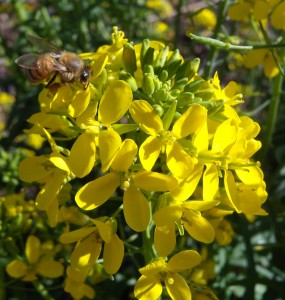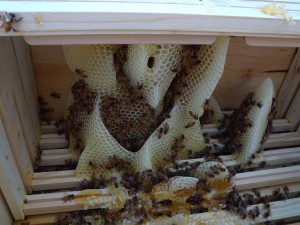 We took a huge leap this spring growing our apiary from just one top-bar hive that made it through the winter to a total of 12 hives at summer’s zenith. We gained valuable experience chasing and climbing after swarms, attempting to lure them, purchasing bee packages from both conventional and ‘natural’ sources, and placing hives in seven host gardens. In hindsight, we took on too much, but we sure learned a lot.
We took a huge leap this spring growing our apiary from just one top-bar hive that made it through the winter to a total of 12 hives at summer’s zenith. We gained valuable experience chasing and climbing after swarms, attempting to lure them, purchasing bee packages from both conventional and ‘natural’ sources, and placing hives in seven host gardens. In hindsight, we took on too much, but we sure learned a lot.
Among the lessons…
Never skimp on equipment (keep plenty of assembled frames at the ready)
By this I don’t mean buy every beekeeping gadget. I am embarrassed to say that on several occasions, with multiple swarms showing up in a week, we failed to fill the bee boxes with the proper number of frames. We naively figured we would install the bees in their new home and return in a few days to add the remaining frames. Ha! By week’s end, the bees had invariably created a labyrinth of comb that we were left to cut out, all the while praying the queen was off laying elsewhere.

Did I mention foundationless frames and that, even with the proper number of frames installed, our bees sometimes took it upon themselves to ‘color outside the lines’?
Put wax in the freezer right away!
No, really. It’s another embarrassing admission, but we looked up from dinner one night to notice a wax moth larva suctioning its way up the kitchen wall. Of course, it wasn’t alone. We had to throw out all the harvested wax from our top-bar hive because it was thoroughly and revoltingly infested.
Short distance bee moving tricks really don’t work
At least not for us. After reading Michael Bush’s instructions for moving hives short distances, we were inspired to give it a try. Actually, we were in a bit of a bind when a telephone pole technician came upon us gardening in our pajamas and informed us that the rotten pole in the back corner was about to fall over and would have to be replaced. He assured us that a crane-driving crew would be out in the next few days.
As it happens, the crew has still not arrived, but we moved our top-producing hive of the season, Dave, the following day. It was fall, but Dave, sitting in the shadow of the pole, was still going gangbusters. We moved it across the garden, carefully arranging a veritable jungle of branches and lavender bouquets across the entrance so that no bee could possibly leave home without realizing that something had changed. Though we did see bees reorienting after the move, the air around the pole was clouded with bees for the next week, and Dave’s population crashed. It died out completely a short time later.
When closing a hive entrance, get it right the first time
This is another beekeeping mishap to fess up to. We went to pick up a colony that had moved into a friend’s swarm lure. It was a warm spring evening, and we found the bees roaming around the hive entrance. No problem, we were prepared to wait. As we sat watching the hive in the gathering dusk, a bee flew out and stung me behind the ear—my first ever honey bee sting, believe it or not. A second bee crawled up Kelly’s pant leg and stung her, too.
The bees never went in that night (at least not before we left at 11:30). The next night, we were back, armed with extra supplies and determined to wait them out.
We sat in the car and listened to NPR for a while. Then Kelly wrote a poem. It was thoroughly dark, but the bees still milled about at the entrance.
Feeling impatient and sorry for ourselves, we finally judged that the bees were almost really inside. We chose our moment and slapped on the block of wood we had selected to close the entrance and started taping it in place. That’s when we noticed a stampede of angry bees exiting through a small gap in the block.
Long story short, we retreated and drove to a late night used bookstore before returning to the hive for another try. By this point, the whole colony seemed to have decided that something fishy was afoot and that nobody had better go to bed. We gave up after midnight.
We did finally manage to close the hive the following night with a piece of wood cut to exact measurements, and a bottle of borrowed Bee Quick in hand, but the whole drawn out experience taught us to never ever take bees’ cooperation for granted and to come prepared to do our job right the first time.

